World’s 8 honey bee species
Discover the honey making bee species
[in this article we don’t mention bumblebees and stingless bees]

General overview: honey bee species worldwide
On our planet, we count 8 honey bee species.
Keep in mind that there are many types of bees and honey bees represent only a small fraction of the roughly 20,000 known species of bees. But now, let’s focus on honey bees:
There are:
-> 2 small honey bee species (Micrapis) with single exposed combs: Apis florea and Apis andreniformis
-> 2 large honey bee species (Megapis) with single exposed combs: Apis dorsata and, Apis laboriosa
-> 4 middle-sized honey bee species (Apis) nesting with multiple combs in cavities: Apis mellifera, Apis cerana, Apis koshevnicovi, Apis nigrocincta.
7 out of those 8 honey bee species seem to originate from South Asia and Southeast Asia, with the exception of Apis mellifera1.
Let’s learn about them in detail:
1. Giant honey bee (Apis dorsata)
Common, open-air nests, non-domesticated, giant
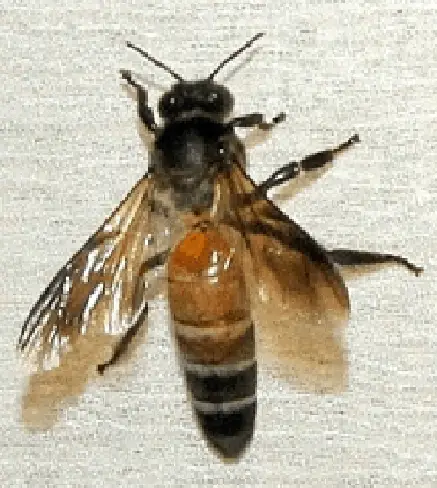
Apis Dorsata

Nest of Apis dorsata
General information:
Apis dorsata, the giant honey bee, is a honey bee of South and Southeast Asia.
Many crops in southern Asia depend on the wild Apis dorsata, even if this honey bee species is not managed by beekeepers. These crops include cotton, mango, coconut, coffee, pepper, star fruit, and macadamia. Yet, there are no reliable estimates on the actual economic contribution of Apis dorsata pollination2.
Appearance:
Apis dorsata has similar colors to Apis mellifera, presenting golden, black and pale bands on the abdomen and with a hairy thorax.
The difference? It is huge compared to Apis mellifera. The length of a worker bee is around 17–20 mm (0.7–0.8 in).
Nesting habit:
The giant honey bee builds open nests that hang from tree branches, and sometimes from buildings.
They build a single large comb up to 150 cm in length and 70 cm tall in a conical shape. Here you can see a typical nest hanging under a tree branch with up to 100.000 worker bees.
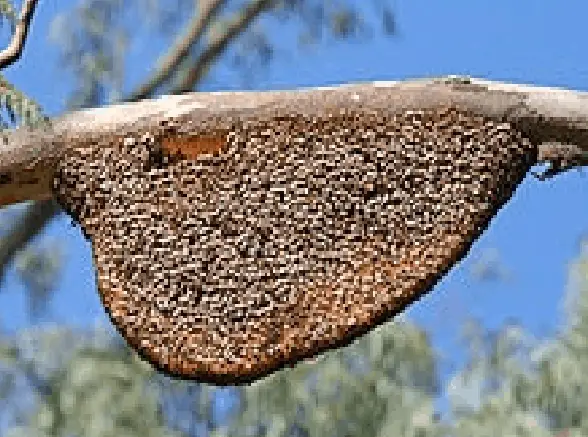
Nest of Apis dorsata under a tree branch
This curtain is several layers of bees thick. It forms a protective barrier separating the vulnerable brood from the outside world.
This curtain is sufficient to protect the nest during storms with heavy wind and rain.
The bottom of the comb has a number of unoccupied hexagonal cells.
Each colony can have up to 100,000 bees and is separated by only a few centimeters from the other colonies in an aggregation. Apis dorsata can form dense aggregations at one nesting site; sometimes with up to 200 colonies in one tree.
About 3–4 weeks after nesting, a colony can store 4 to 6 kg of honey. They store honey in the upper corner of the nest.
The colony leaves behind an empty comb when it departs from a nest site. Interestingly, scientists observed that the same colony can return to the exact same branch six months later. This is astonishing when keeping in mind that bees that knew of the old nesting location would have died long before (!)
Character and special traits:
Longer flights: The large body size of Apis dorsata allows these bees to have a greater flight and foraging range than those of other honey bee species.
Aggressive & defensive: When disturbed, Apis dorsata colonies are famous for their aggressive defense strategies. In fact, the Giant honey bee is described as one of the most dangerous animals of the southeastern Asian jungles. It is considered the most defensive of all of the honey bees, even more defensive than the African honey bee.
Their main weapons are stingers that are up to 3 mm long and easily penetrate clothing and even the fur of a bear.
Smart and calculating: Large numbers of Apis dorsata attack a perceived threat, though only a few provide the painful stings because the bees will die shortly after stinging. The other bees will buzz loudly and bite the threat to deter the threat, without risking the lives of many individuals
Strategic: These bees have evolved a unique method of defense to deter predators from attacking their exposed nests. An alarmed guard bee will fly back to the nest and, with an exposed stinger, run in a zigzag pattern along the curtain of bees. The bees will then run to the lower rim of the comb and create large thin chains of bees while making a hissing sound. This act not only prepares the guard bees for attack, but also makes the nest look larger than it is. This defense is particularly useful against bird predators that try to rip sections of brood from the comb, because the birds often attack the bottom of the comb, grabbing only handfuls of bees.
Giant honey bees are smarter than you think!
Defensive through distraction: Apis dorsata uses another fascinating method of defense known as shimmering. Shimmering involves a display of waves that moves across the surface of the nest in a fraction of a second as the bees raise their abdomens in sequential order. These waves originate from individual bees which perceive a predator and raise their abdomen first, invoking a similar response from the surrounding bees. The visual display of shimmering is thought to intimidate potential threats such as predatory wasps, birds, and mammals.
Interaction with humans:
Not domesticated: Though not domesticating it by forcing them to live in hives, indigenous peoples have traditionally used this species as a source of honey and beeswax, a practice known as honey hunting3.
One exception to the non-domesticated relationship with humans is the case of the people practicing rafter beekeeping in the Melaleuca forests of Southern Vietnam:
Rafter Beekeeping:
In some Melaleuca forests in Vietnam, people use a traditional method of collecting honey and wax from A. dorsata colonies. This method of “rafter beekeeping” was first reported in 1902. According to Vietnamese sociologists, in the early 19th century, honey hunting or raftering was the most important occupation of the people who lived in the Melaleuca forest swamp. The technique is still used today at the state farm of Song Trem in U Minh District. According to a survey, about 96 beekeepers are in the area.
2. Cavity Nesting Asian honey bee (Apis cerana)
Common, cavity-nesting, domesticated, medium-size
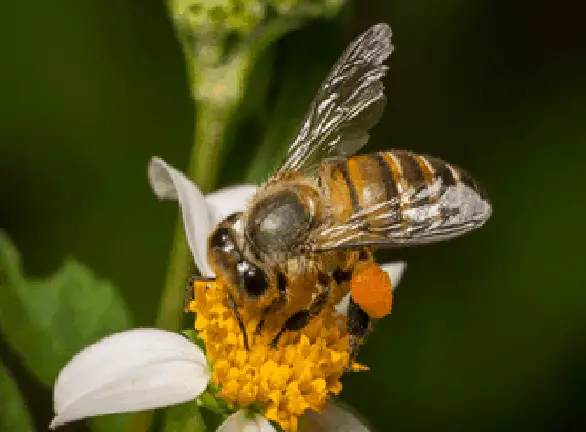
Apis Cerana
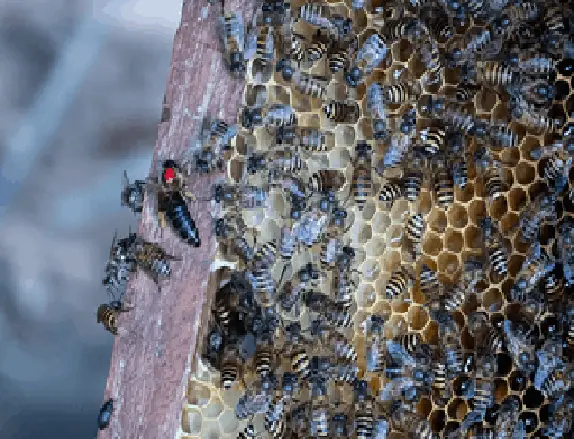
Tổ Nest of Apis cerana
General information:
Apis cerana, the eastern honey bee or the Asiatic honey bee, is a species of honey bee native to southern, southeastern, and eastern Asia. Apis cerana colonies are relatively small, with only around 6,000 to 7,000 workers. In comparison, Apis mellifera colonies can reach sizes of up to 50,000 individuals.
Appearance:
Their size is similar or somewhat smaller than Apis mellifera, and they also have more visible abdominal stripes. Adult worker bees of Apis cerana are black in color, with four yellow abdominal stripes.
Nesting habit:
Apis cerana colonies are known for building nests consisting of multiple combs in cavities. The nests have a small entrance, presumably for defense against invasion by individuals of another nest. As a type of honey bee, Apis cerana must collect and store around a third of its nectar in a concentrated form in order to ensure an adequate supply for consumption during winter time.
Character:
Robust: Apis cerana is found at altitudes from sea level up to 3,500 metres in areas with appropriate flora and climate. This bee species has adapted to adverse climatic conditions and can survive extreme fluctuations in temperature and long periods of rainfall. It is unique in its ability to survive temperatures as low as -0.1ºC, a temperature lethal for other bee species (Apis mellifera).
Defensive through heat: Thermal defense: When an A. cerana hive is invaded by the Japanese giant hornet (Vespa mandarinia), about 500 Japanese honey bees (A. cerana japonica) surround the hornet and vibrate their flight muscles until the temperature is raised to 47 °C (117 °F), heating the hornet to death, but keeping the temperature still under their own lethal limit (48–50 °C).
Defensive through distraction: During this period of self-defense, bees collectively execute carefully timed waves of shimmering of their wings when approached by predators such as Vespine wasps. This appears to serve as a distraction technique of visual pattern disruption that results in confusing predators. As a result, predators are unable to continue attacking additional bees, and are therefore unsuccessful in this endeavor.
Interaction with humans:
[footnte]https://beekeeping.fandom.com/wiki/Apis_cerana[/footnte]
Wild & domesticated: It is still found in the wild, where it nests in tree holes, fallen logs, and crevices, but it is also one of the few bee species that can be domesticated. Like the Western honey bee, they are domesticated and used in beekeeping, mostly in wooden boxes with fixed frames.
Apis cerana and its high-quality honey:
Honey production is lower than for Apis mellifera, because they form smaller colonies. However, it is being increased through a focused queen breeding and selection program. Another difficulty with Apis cerana: their radius of foraging activity at 2 km is half that of Apis mellifera. This means that a colony covers only a quarter of the area covered by Apis mellifera and therefore one colony of Apis cerana produces one quarter of the honey produced by an Apis mellifera colony. In Japan, due to this fact, the honey from Apis cerana can be sold at a higher price.
Specialized in low temperatures: The bees are also important pollinators, ensuring the pollination of mountain crops, especially early flowering fruit and vegetables. It is available when temperatures are still too low for the exotic Apis mellifera species, and still flies under cool and cloudy conditions.
Disease-resistant: Apis cerana suffers from hardly any disease. It is not necessary to administer medicines to the bees and the honey is free from residues of any unnatural chemicals.
3. Rock honey bees (Apis laboriosa)
Rare, open-air, non-domesticated, giant from the Himalayas producing “mad honey”
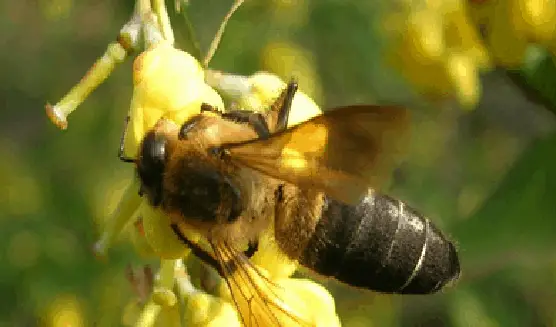
Apis dorsata laboriosa
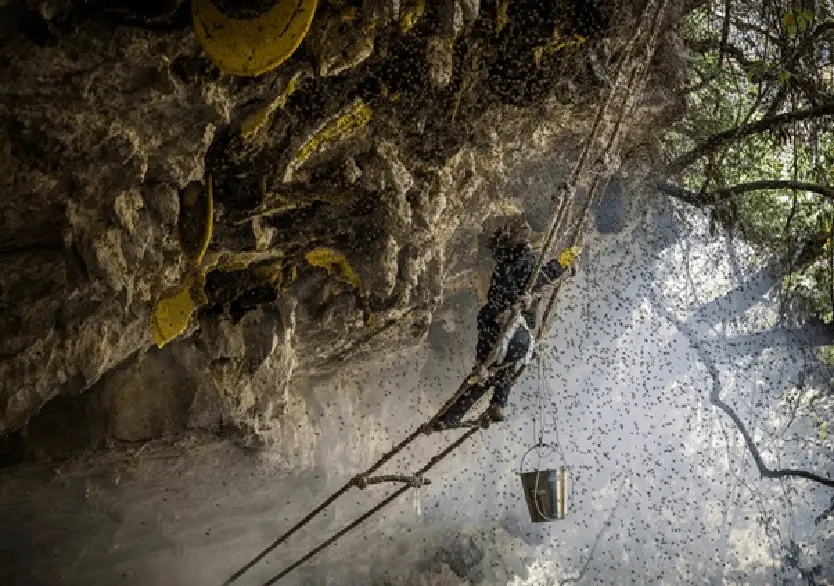
Honey hunting of “mad honey” in Nepal
General information:
Apis dorsata laboriosa, the Himalayan giant honey bee, is the world’s largest honey bee. Its distribution is usually limited to the Himalayas4.
Appearance:
Single adults can measure up to 3.0 cm (1.2 in) in length.
This honey bee species has the largest worker bee body size. The bodies of A. laboriosa worker bees are brown-black as compared to a bronze color in A. dorsata.
Nesting habit:
It mostly nests at altitudes between 2,500 and 3,000 m (8,200 and 9,800 ft), building very large nests under overhangs on the southwestern faces of vertical cliffs. One nest can contain as much as 60 kg (130 lbs) of honey. The bees forage at altitudes of up to 4,100 m (13,500 ft).
Cliff observation revealed that most of the cliffs are located in very difficult terrain. For a good reason! Those locations are practically impossible to reach for humans.
Interaction with humans:
The practice of hunting honey is a very ancient art and still exists in many parts of the Hindu Kush Himalaya region. As a result, more than 50% of honey produced in this region comes from honey hunters. The traditional value of this practice is an important element of the lifestyle of Razis and Kurumbas in Nepal and India respectively. In Nepal and particularly in Kaski, there is a collective-ownership system on Apis laboriosa colonies, which means that colonies belong to the village, which has either land ownership or common property rights on the cliff. 5
The “mad honey”
Apis laboriosa is the only bee producing the famous red honey. Red honey has an intoxicating effect and various relaxing qualities that decrease over storage. Red honey is famous for its purported medicinal value and intoxicating qualities. Those qualities stem from grayanotoxin present in the white rhododendrons (Rhododendron spp) nectar, which bees collect to make the honey. Traditionally, the Gurung people in Nepal developed the use of this mad honey, both for its medicinal and hallucinogenic properties.
4. Red Dwarf honey bees (Apis florea)
Common, open-air, non-domesticated, small, and red
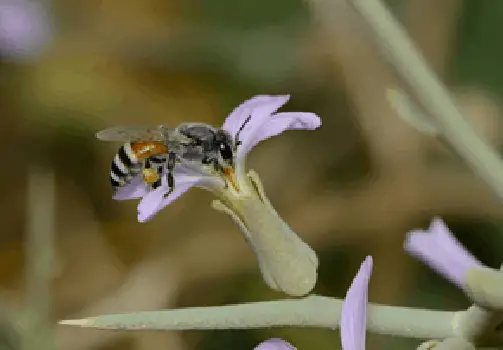
Apis florea
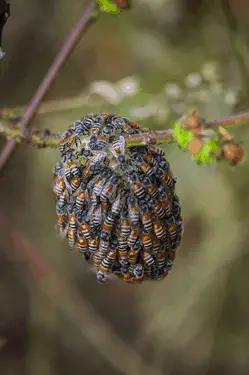
Nest of Apis florea
Appearance:
Apis florea is the red dwarf honey bee. It owns this name due to its small size compared to other honey bees. A worker is typically 7–10 mm in body length and its overall coloration is red-brown. Old workers always have a red first abdomen and have light whitish hair covering their thorax and legs. Younger workers are paler in color, as is the case in Giant honey bees.
Nesting habit:
Normally, they nest with a single comb in the open air like A. dorsata. Apis florea have open nests and small colonies, which makes them more susceptible to predation than cavity nesters with large numbers of defensive workers. Both species build their nests on branches, typically in areas with more dense, darker foliage. A colony builds a single, exposed comb usually on tree branches or shrubs.
If they are building a new nest near (migrating less than 200 meters) to the old one, they salvage the wax from the old nest. Other honey bee species do not show this behavior, perhaps because of the risk of contaminating pathogens. Scientists observed this wax-saving behavior only in Apis florea.
Character:
Defensive (hissing): A. florea show highly specific social defense mechanisms when they sense predators nearby. For instance, they typically display hissing and shimmering behavior. In addition, they choose nesting locations in dense foliage to camouflage themselves from potential predators.
Sticky against ants: A brilliant defense example is the specific behavior in response to their predominant predator, the O. smaragdina weaver ant. When these ants are in close proximity, the bees produce and deposit sticky barriers to obstruct their path. The guard bees take cover at this sticky zone and start to alert other bees using specific hissing sounds with the goal of preventing full-blown raids by the ants. Over time, more bees are recruited to contribute to this sticky zone barrier which reinforces their defense. Read also our article Bees against ants, written by a quiet observer who experienced this battle first hand.
Communicative (piping): Apis florea employ a defensive strategy called “piping”, in which one individual emits an initial warning signal (“piping”), which is followed 0.3-0.7 seconds later by a general response from a large number of bees (“hissing”). Hissing is a noisy, broadband signal that is also audible to the human ear and produced by slight movements of the bees’ wings. Individuals close to the piping bee are the first to hiss. It then spreads rapidly to neighbors until an impressive coordinated crescendo is produced by the entire colony. Piping and hissing are accompanied by workers ceasing activities such as foraging dancing and departures from the colony.
Interaction with humans:
Harmless stings: Their stings are often not capable of penetrating human skin. Consequently, people handle the hive and swarms with minimal protection.
Apis florea produce honey that is harvested and eaten in Thailand and Cambodia. In Asia, there is widespread hunting of these bees because they are harmless to humans. They also have social and cultural significance to the two main religions in Asia: Hinduism and Buddhism. In Hindu culture, the honey from such bees represents “the blendedness of everything”. It is served with other ingredients in a variety of traditional ceremonies. In Buddhist culture, gifting honey to fellow monks is considered equal to giving alms.
5. Black Dwarf honey bees (Apis andreniformis)
Rare, open-air, non-domesticated, small black sister of Apis florea

Apis andreniformis

Nest of Apis andreniformis
General information:
Apis andreniformis is the black dwarf honey bee. It is the smallest of all species of honey bees (between 6.5 mm and 9.5-10 mm). Along with Apis florea it constitutes the subgenus Micrapis (or dwarf honey bees). It is a relatively rare species of honey bee whose native habitat is the tropical and subtropical regions of Southeast Asia.
Distribution:
Apis andreniformis is a lowland species because biologists find them mostly in elevations below 1,000 m. They may migrate to higher elevations during rainy seasons. Similarly, they mostly nest in tropical and subtropical regions, while cavity-dwelling honey bees are more common to colder climates.
Appearance:
We can distinguish Apis andreniformis from other Apis species by noting their dark black coloration. It makes them the darkest of their genus. Its first two abdominal segments are black and its scutellum is yellow.
Nesting habit:
A. andreniformis make nests out of a single comb hanging from small twigs in quiet forests. The dwarf bees usually build the nest between 1 and 15 meters from the ground, though the average altitude is 2.5 m. While creating the nest, plant resin is placed along the supporting branch and around the edges of the nest.
This acts as a barrier against small insects, like ants, that may try to enter the nest. The major location of honey storage is mostly in the area above and surrounding the branch.
Character:
Defensive: Apis andreniformis has a stronger defensive behavior than A. florea, particularly when intruders come within 2 m of the nest.
Unable to recognize peers: Studies found that A. andreniformis might be unable to recognize its own species and nestmates. Scientists deducted this inability when observing queenless colonies of A. florea. The queens joined a colony of A. andreniformis without facing aggression upon their initial arrival.
Interaction with humans: Humans work with this species to prepare some commercial products like honey, wax, royal jelly, and bee venoms. They are important pollinating agents in their region of occurrence.
6. Koschevnikov’s honey bee (Apis koschevnikovi)
Rare, cavity-nesting, non-domesticated, medium-sized and reddish

Apis mellifera
Koschevnikov’s honey bee is also called the “red bee of Sabah” due to distinctive reddish metasoma and legs. This is true only for Apis koschevnikovi in Sabah State, Borneo, Malaysia. Differently, on the Malay Peninsula and on Sumatra, Indonesia Apis koschevenikovi has a dark, coppery color. Its habitat is limited to the tropical evergreen forests of the Malay Peninsula, Borneo and Sumatra.
Worker bees have a moderate body size (forewing length between 7.5–9 mm)6.
7. Philippine honey bee (Apis nigrocincta)
Rare, cavity-nesting, non-domesticated, medium-sized, and reddish
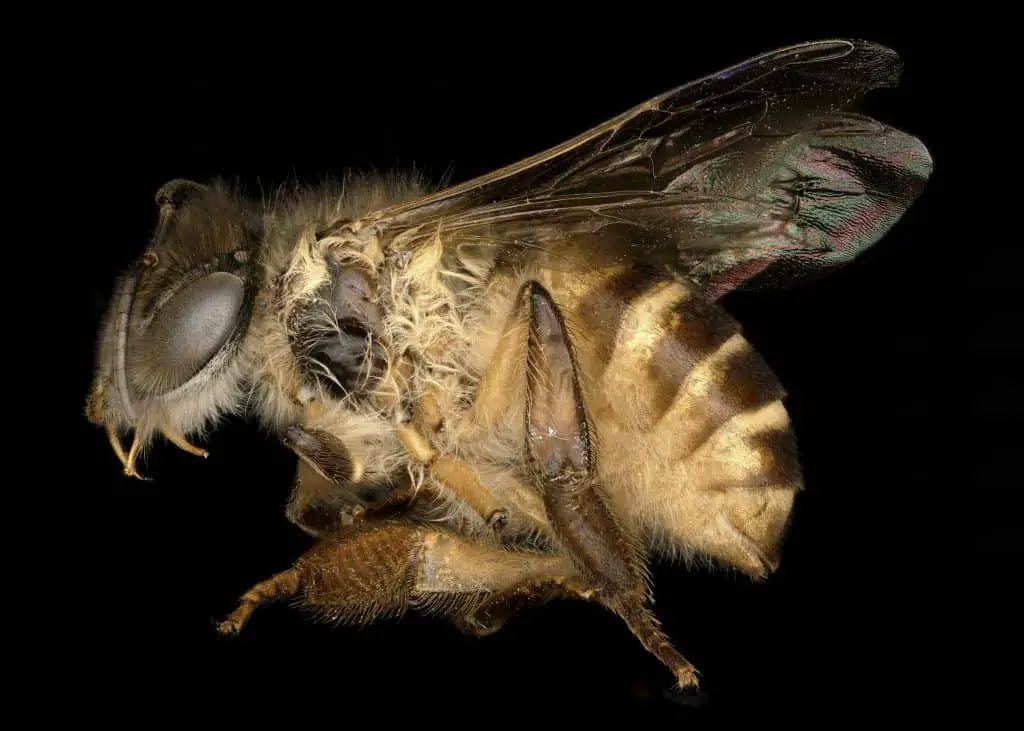
Apis nigrocincta
The Philippine honey bee is a cavity-nesting species. The species has rust-colored scapes, legs, and clypeuses, with reddish-tan hair color that covers most of the body. Scientists found it on Mindanao Island, Philippines and Sulawesi, Indonesia7.
8. Western honey bee (Apis mellifera)
Common, cavity-nesting, domesticated, medium size

Apis mellifera
Find out everything about the world’s famous honey bee, Apis Mellifera.
This honey bee species comprises an interesting variety of races, subraces, and hybrids, which are essential to the world of commercial beekeeping.



